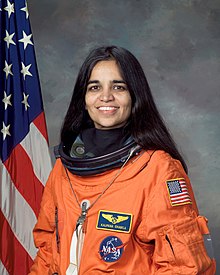Indian Americans
Indian Americans are citizens of the United States with ancestry from India. The terms Asian Indian and East Indian are used to avoid confusion with Native Americans in the United States, who are also referred to as "Indians" or "American Indians." With a population of more than 4.9 million, Indian Americans make up approximately 1.35% of the U.S. population and are the largest group of South Asian Americans, the largest Asian-alone group,[10] and the largest group of Asian Americans after Chinese Americans. Indian Americans are the highest-earning ethnic group in the United States.[11]
"Asian Indians" redirects here. For people from India, see Indian people. For people from the Indian subcontinent, see South Asian ethnic groups.Terminology[edit]
In the Americas, the term "Indian" had historically been used to describe indigenous people since European colonization in the 15th century. Qualifying terms such as "American Indian" and "East Indian" were and still are commonly used in order to avoid ambiguity. The U.S. government has since coined the term "Native American" in reference to the indigenous people of the United States, but terms such as "American Indian" remain among indigenous as well as non-indigenous populations. Since the 1980s, Indian Americans have been categorized as "Asian Indian" (within the broader subgroup of Asian American) by the U.S. Census Bureau.[12]
While "East Indian" remains in use, the term "Indian" and "South Asian" is often chosen instead for academic and governmental purposes.[13] Indian Americans are included in the census grouping of South Asian Americans, which includes Bangladeshi Americans, Bhutanese Americans, Maldivian Americans, Nepalese Americans, Pakistani Americans, and Sri Lankan Americans.[14][15]
Culture and technology[edit]
Commerce[edit]
Patel Brothers is a supermarket chain serving the Indian diaspora, with 57 locations in 19 U.S. states—primarily located in the New Jersey/New York Metropolitan Area, due to its large Indian population, and with the East Windsor/Monroe Township, New Jersey location representing the world's largest and busiest Indian grocery store outside India.
The United States is home to various associations that promote Indian languages and cultures. Some major organizations include:
Several groups have tried to create a voice for Indian Americans in political affairs, including the United States India Political Action Committee and the Indian American Leadership Initiative, as well as panethnic groups such as South Asian Americans Leading Together and Desis Rising Up and Moving.[204][205][206][207] Additionally, there are industry groups such as the Asian American Hotel Owners Association and the American Association of Physicians of Indian Origin.
In the 2000s, a majority of Indian Americans have tended to identify as moderates, and have often leaned Democratic in several recent elections. In the 2012 presidential election, a poll from the National Asian American Survey reported that 68% of Indian Americans planned to vote for Barack Obama.[208] Polls before the 2004 presidential election showed Indian Americans favoring Democratic candidate John Kerry over Republican George W. Bush by a 53% to 14% margin, with 30% undecided at the time.[209]
By 2004, the Republican party endeavored to target this community for political support,[210] and in 2007, Republican Congressman Bobby Jindal became the first United States Governor of Indian descent when he was elected Governor of Louisiana.[211] In 2010, Nikki Haley, also of Indian descent and a fellow Republican, became Governor of South Carolina in 2010. Republican Neel Kashkari is also of Indian descent and ran for Governor of California in 2014. Raja Krishnamoorthi who is a lawyer, engineer and community leader from Schaumburg, Illinois has been the Congressman representing Illinois's 8th congressional district since 2017.[212] Jenifer Rajkumar is a Lower Manhattan district leader and the first Indian American woman elected to the state legislature in New York history.[213] In 2016, Kamala Harris (the daughter of a Tamil Indian American mother, Dr. Shyamala Gopalan Harris, and an Afro-Jamaican American father, Donald Harris[214][215][216]) became the first Indian American[217] and second African American female to serve in the U.S. Senate.[218]
In 2020, Harris briefly ran for President of the United States and was later chosen as the Democratic Party's vice-presidential nominee, running alongside Joe Biden.[219]
In the 2024 United States Presidential Election, Vivek Ramaswamy ran as a candidate for the Republican Party. Ramaswamy would then leave the race to endorse Donald Trump.[220]
Indian Americans have played a significant role in promoting better India–United States relations, turning the cold attitude of American legislators to a positive perception of India in the post-Cold War era.[221]















